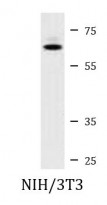ARG42551
anti-KLHL12 antibody
anti-KLHL12 antibody for Western blot and Human,Mouse
Overview
| Product Description | Rabbit Polyclonal antibody recognizes KLHL12 |
|---|---|
| Tested Reactivity | Hu, Ms |
| Tested Application | WB |
| Host | Rabbit |
| Clonality | Polyclonal |
| Isotype | IgG |
| Target Name | KLHL12 |
| Antigen Species | Human |
| Immunogen | KLH-conjugated synthetic peptide between aa. 376-404 of Human KLHL12. |
| Conjugation | Un-conjugated |
| Alternate Names | DKIR; DKIR homolog; hDKIR; CUL3-interacting protein 1; C3IP1; Kelch-like protein 12 |
Application Instructions
| Application Suggestion |
|
||||
|---|---|---|---|---|---|
| Application Note | * The dilutions indicate recommended starting dilutions and the optimal dilutions or concentrations should be determined by the scientist. | ||||
| Positive Control | HeLa and NIH/3T3 | ||||
| Observed Size | ~ 63 kDa |
Properties
| Form | Liquid |
|---|---|
| Purification | Purification with Protein A and immunogen peptide. |
| Buffer | PBS and 0.09% (W/V) Sodium azide. |
| Preservative | 0.09% (W/V) Sodium azide |
| Storage Instruction | For continuous use, store undiluted antibody at 2-8°C for up to a week. For long-term storage, aliquot and store at -20°C or below. Storage in frost free freezers is not recommended. Avoid repeated freeze/thaw cycles. Suggest spin the vial prior to opening. The antibody solution should be gently mixed before use. |
| Note | For laboratory research only, not for drug, diagnostic or other use. |
Bioinformation
| Database Links | |
|---|---|
| Gene Symbol | KLHL12 |
| Gene Full Name | kelch-like family member 12 |
| Background | This gene encodes a member of the KLHL (Kelch-like) family of proteins. This protein has been identified as an autoantigen in the autoimmune disease Sjogren's syndrome and as a potential biomarker in primary biliary cirrhosis. This protein may act as a substrate adaptor of the Cullin-3 ubiquitin ligase complex to promote substrate-specific ubiquitylation. Ubiquitylation by this complex has been shown to regulate the Wnt signaling pathway as well as COPII vesicle coat size. A pseudogene has been identified on chromosome 22. Alternative splicing results in multiple transcript variants. [provided by RefSeq, Dec 2014] |
| Function | Substrate-specific adapter of a BCR (BTB-CUL3-RBX1) E3 ubiquitin ligase complex that acts as a negative regulator of Wnt signaling pathway and ER-Golgi transport (PubMed:22358839, PubMed:27565346). The BCR(KLHL12) complex is involved in ER-Golgi transport by regulating the size of COPII coats, thereby playing a key role in collagen export, which is required for embryonic stem (ES) cells division: BCR(KLHL12) acts by mediating monoubiquitination of SEC31 (SEC31A or SEC31B) (PubMed:22358839, PubMed:27565346). The BCR(KLHL12) complex is also involved in neural crest specification: in response to cytosolic calcium increase, interacts with the heterodimer formed with PEF1 and PDCD6/ALG-2, leading to bridge together the BCR(KLHL12) complex and SEC31 (SEC31A or SEC31B), promoting monoubiquitination of SEC31 and subsequent collagen export (PubMed:27716508). As part of the BCR(KLHL12) complex, also acts as a negative regulator of the Wnt signaling pathway by mediating ubiquitination and subsequent proteolysis of DVL3 (PubMed:16547521). The BCR(KLHL12) complex also mediates polyubiquitination of DRD4 and PEF1, without leading to degradation of these proteins (PubMed:18303015, PubMed:20100572, PubMed:27716508). [UniProt] |
| Cellular Localization | Cytoplasmic vesicle, COPII-coated vesicle. [UniProt] |
| Calculated MW | 63 kDa |
Images (2) Click the Picture to Zoom In







